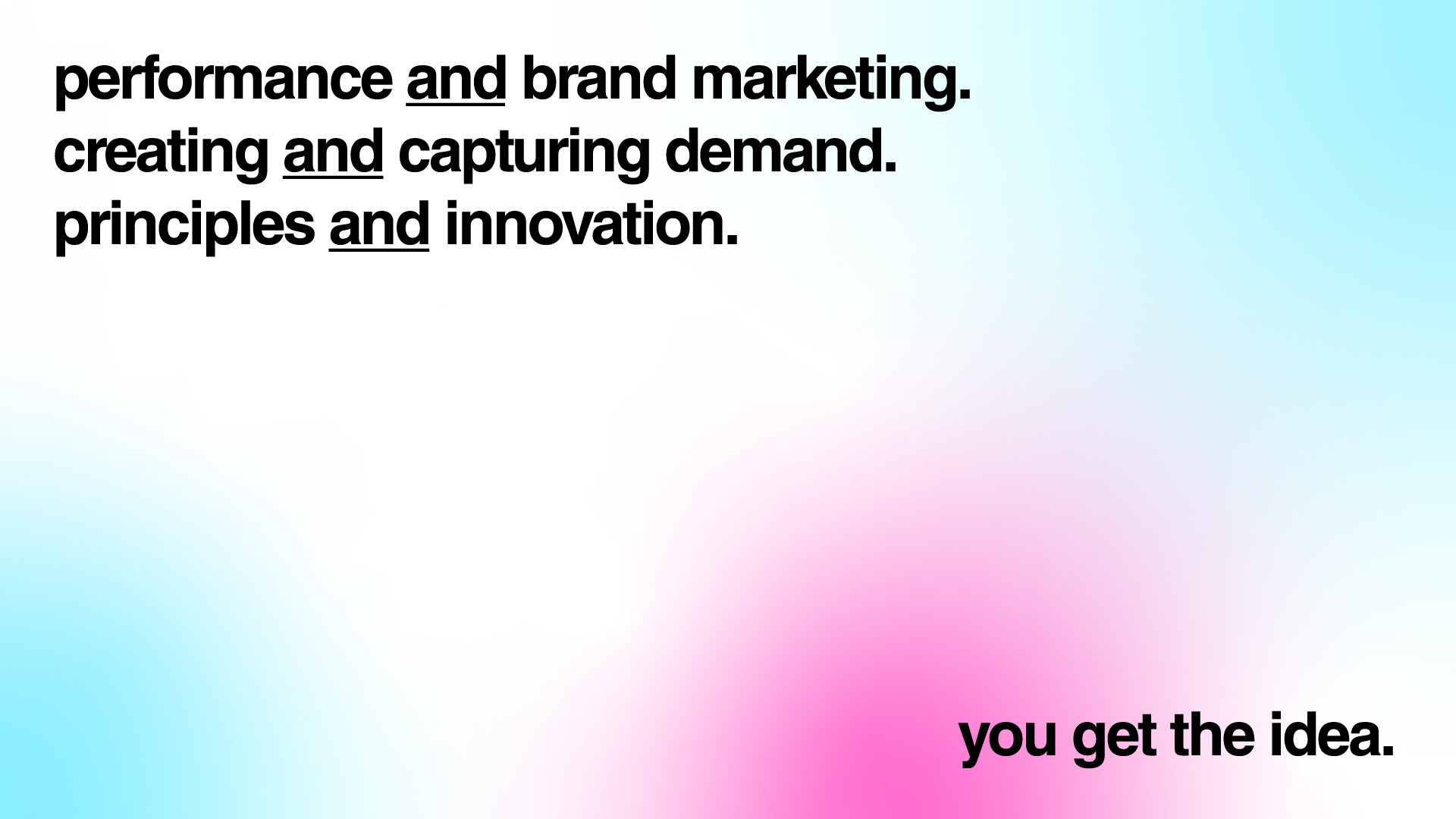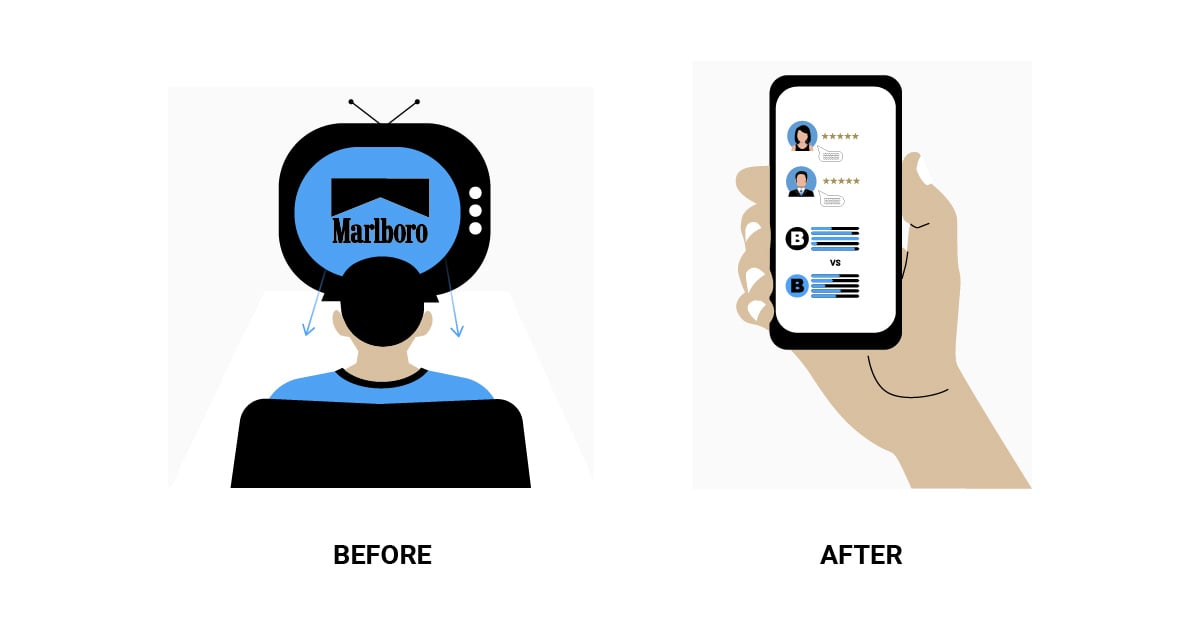End-To-End Brand Measurement and Execution
10 minute read
Brand measurement has come a long way. The marketing industry initially only had surveys to rely on. Eventually, we learned to supplement surveys with digital signals and sophisticated Marketing Intelligence platforms to make measuring brands faster,
more accurate, and more transparent. We learned that progress doesn't necessarily come from replacing one method with the other, it comes from combining them and collaborating to create better results.
This blog post presents an even better brand measurement framework, one that's borne out of an end-to-end collaboration between all brand teams across all timespans, combining traditional and digital. To fully understand why an end-to-end approach matters, we must first revisit the brand-building basics.
The Brand Lifecycle
One-size-fits-all brand measurement frameworks rarely work because brands are contextual. We must first acknowledge that how brand marketers approach measuring and improving brands will be determined by the distinct stage in which a brand exists. These stages are holistically known as the brand lifecycle. The brand lifecycle consists of 5 stages: Brand Strategy, Brand Formation, Brand Activation, Brand Measures, and Business Outcomes.
Each brand lifecycle stage has unique implications. These implications vary based on timeframes (How long does it take for these marketing effects to take shape? How often should they be measured? Does this inform short-term or long-term decisions?), automatability (Could we automate this, or can this only be done by a human?), and quantifiability (can we put a hard number on this, or is this based on situational interpretation?). As a rule of thumb, concepts that are based on lagging effects and subjective opinions are difficult to automate. They are best infrequently analyzed by human marketers using traditional means such as surveys. Concepts on the opposite end of this spectrum should be measured and improved very frequently using AI-based Marketing Intelligence
platforms such as BrandOps.
In case you don't achieve end-to-end brand measurement across the entire brand lifecycle and are forced to compromise for measuring and improving limited parts of it, you can still do it very successfully and efficiently - so long as you're aware of the implications of each brand lifecycle stage. Let's learn more about the brand lifecycle by breaking it down.
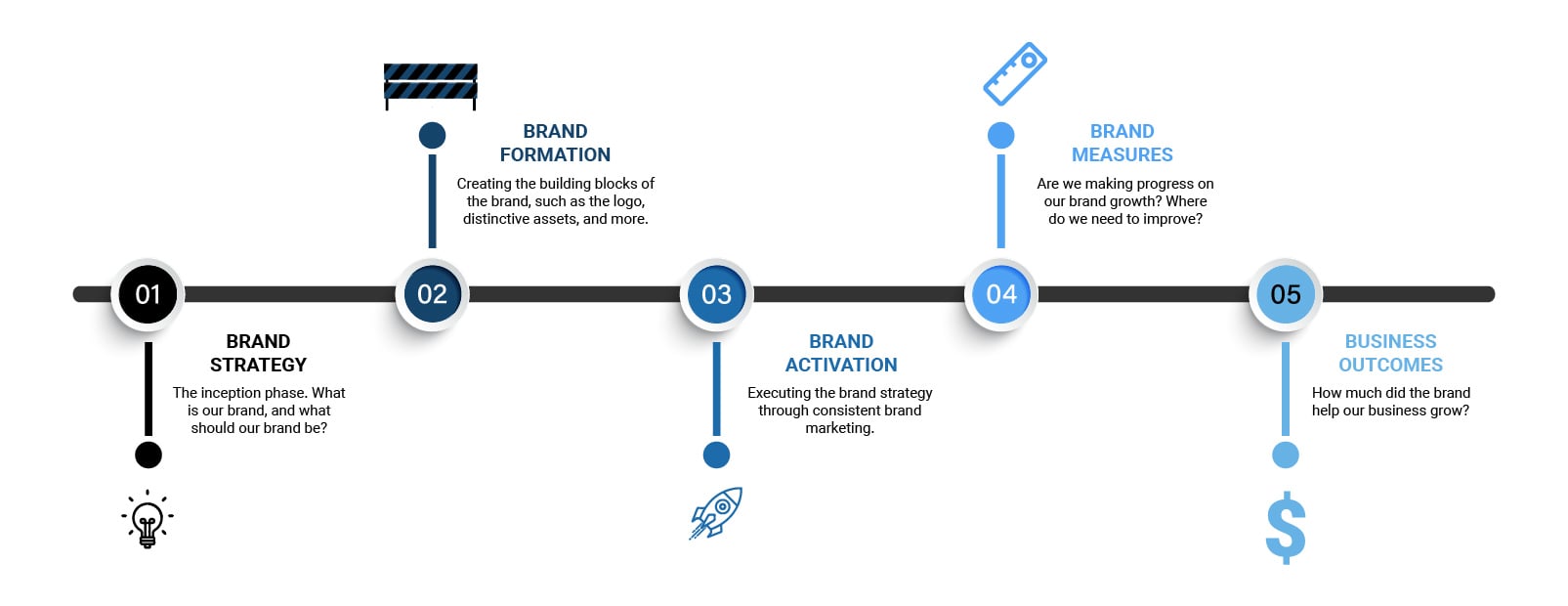
Brand Strategy
Brand strategy is the inception phase of a brand's life. It serves to address two main questions: what is our brand, and what should our brand be? A brand strategy helps stakeholders align on the direction of the brand for years or even decades to come. Common concepts discussed during the brand strategy phase include but are not limited to the brand purpose, visual identity design, brand personality, tone of voice, and brand architecture.
The nature of these concepts is largely subjective. As such, it's difficult to put a hard number on them. Brand marketers will get better insights by evaluating these themes through surveys and interviews over long periods (annually at the earliest). And although
it's an important part of any brand, brand strategy in isolation has no value. Unless marketers take action, the brand strategy is just another document that collects dust. It must be executed. This leads us to the next stage of the brand lifecycle: Brand Formation.
Brand Formation
Brand Formation refers to the core elements on which a brand is built. Some brand marketers think of brand formation as the extension of brand strategy. Brand Formation includes concepts such as brand differentiation, Category Entry Points, mental availability, or brand associations. These elements can act as amplifiers of a brand's success in the market. For example, a brand that has obvious differentiation will likely enjoy more buyer attention. Brand Formation elements can be goals in and of themselves. The stronger and more numerous brand formation elements are, the greater the effects on the brand's key growth metrics will be.
Brand Formation concepts are very contextual and qualitative. Measuring them is best done by humans that can interpret nuance because MarTech and AI are not advanced enough for these tasks yet. Brand Formation elements take years or decades to come to fruition, so marketers aren't expected to measure them frequently. Furthermore, creating and growing brand formation elements requires long-term brand activation, which we will discuss next.
Brand Activation
The prep work of research and strategy is behind us. This is the point when the rubber hits the road, and it's time to execute the brand strategy. Brand Activation is the tie that binds brand strategy with the market reality. Without it, a brand cannot be built. Activation happens through consistent marketing activities across many channels over long periods. Unlike any other form of always-on marketing, brand activation is done with the main purpose of telling the brand story and driving awareness, trust, and affinity among people who are not in the market for a brand today. Publishing blogs, posting on social media, appearing in news, and running brand advertising campaigns are but a few forms of brand activation. The act of doing brand activation is known as brand marketing.
Brand building is largely a long-term process, but not all positive brand outcomes take years to happen. How long it usually takes for your target outcome to happen will determine which type of brand activation is best suited for the job: long-term activation (years or decades), medium-term activation (months or quarters), or short-term activation (weeks to a month). Although there are no rules to brand activation, the choice of brand activation type will usually be obvious. For instance, if the target outcome is to reshape a buyer's perception of a brand, it's unreasonable to expect that to happen in a week. Most marketers will immediately know the brand needs long-term activation, long-term strategies, and long-term metrics. This is why defining the target outcome is often the first step.
- Examples of long-term outcomes: Strong unaided brand awareness. The brand has reshaped buyers' sentiments and perceptions around certain ideas. The brand name has become a synonym for the category itself.
- Examples of medium-term outcomes: The brand is endorsed by influential industry analysts. More buyers search for the brand directly when they're in-market and don't even explore other options.
- Examples of short-term outcomes: The brand has grown its presence across digital channels and is now more easily discoverable. Buyers are spreading the good word about the brand in their trusted communities. The brand is getting more inbound leads.
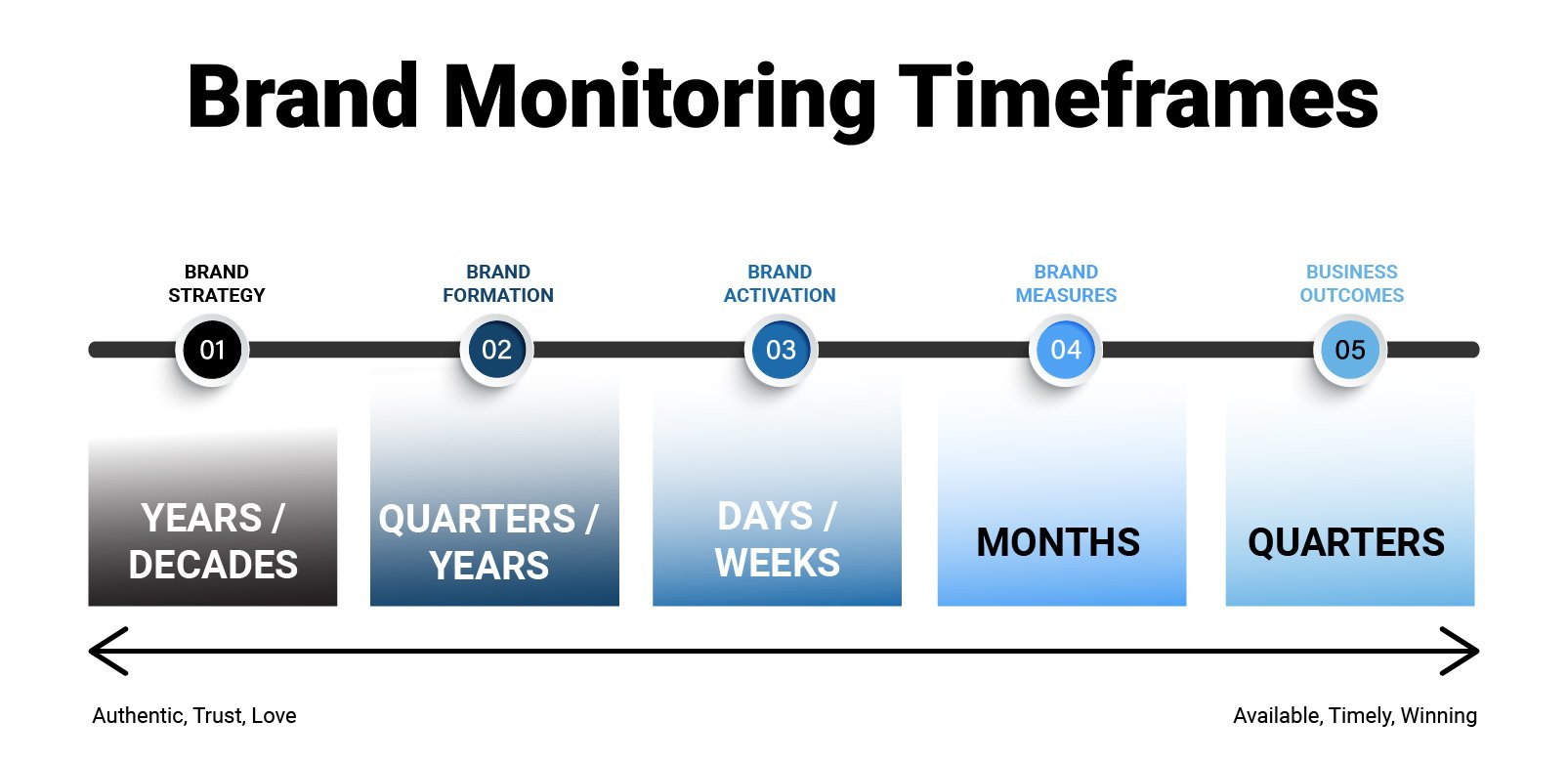
Failing to acknowledge differences between brand activation timeframes often leads to brand marketing teams missing out on immediate brand growth opportunities, becoming disconnected from the rest of the marketing organization, and orienting themselves with measures that aren't suited for the timeframe their target outcomes exist in. We will cover this in more detail in the next brand lifecycle stage: Brand Measures.
Brand Measures
When a marketer mentions brand measurement, chances are that concepts like brand sentiment analysis, comparing brand perceptions, or perhaps measuring unaided brand awareness comes to your mind. For the longest time, brand marketing and brand measures have been equated almost exclusively with such long-term brand outcomes. These long-term outcomes are usually planned in the two earliest brand lifecycle stages: brand strategy and brand formation. While they are very important, they are only a piece of the story. Recognizing that brands go through a lifecycle makes it clear to see why putting a spotlight on brand measures for only two lifecycle stages is problematic. Solving this problem requires marketers to acknowledge there are two types of brand measures: lagging measures and continuous measures.
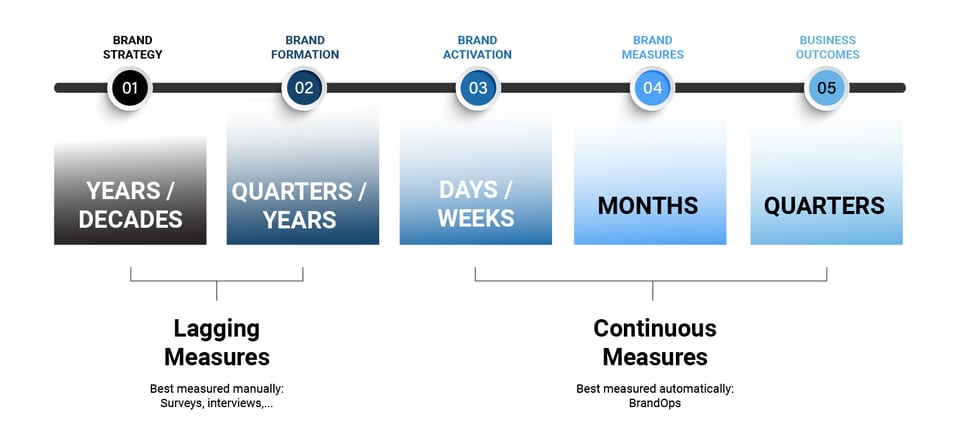
Lagging brand measures take quarters, years, or even decades to significantly change, which is why they are typically measured infrequently by traditional methods such as surveys or focus interviews. Qualitative research methods remain the best choice for lagging brand measures because these measures are contextual. The impact lagging brand measures have on business outcomes is, like lagging brand measures themselves, very slow to take shape, but has an undeniable effect once it happens. Lagging brand measures are mostly a result of long-term brand activation efforts. A common theme among lagging brand measures is that they focus on customer thoughts. Customer thoughts are informed by traditional brand metrics such as unaided brand awareness or brand preference. Lagging brand measures are rich with insights that, despite their slow nature, remain the most accurate predictors of a brand's power in the market, as well as predictors of future growth. However, relying only on lagging brand measures robs brand marketers of the power of growing the business today - something they've been often accused of lacking. This is why brand growth across all timeframes requires brand marketers to use both lagging and continuous measures for a complete, end-to-end brand measurement and execution.
Although they can be used for measuring all brand activation timeframes, continuous brand measures are ideal for informing the success of short-term and medium-term brand activation relative to brand growth and business outcomes. Continuous brand measures focus on customer actions or reactions to a brand. They can be measured in real-time using Marketing Intelligence platforms such as BrandOps. Measuring them by software makes the process actionable, scalable, and easy. Failing to improve on them quickly creates a snowball effect, and before brand marketers know it, their brand is losing ground to a competitor. Continuous brand measures consist of binary signals that can be expressed with hard numbers. These binary signals are metrics and digital touchpoints derived from all digital channels, including but not limited to social followers, mention count, SERP ranking, and similar. Unlike lagging brand measures, there are no "it depends" debates about their credibility.
Continuous brand measures focus on brand outcomes that can be achieved in weeks at the earliest. Brand marketers influence them through day-to-day brand marketing activities such as publishing blog posts, engaging customers on social platforms, getting featured in industry news, and so forth. In a sense, continuous brand measures can also be thought of as the fuel for lagging measures. With it, brand marketers have the power to know how they can improve long-term brand growth today, instead of waiting to find out what they could have done better a year from now. Here at BrandOps, continuous brand measures are summarized into four Brand Pillars: Brand Attention, Presence, Reputation, and Momentum.
Previously, brand marketers used point-data solutions for continuous brand measures. Among the most popular ones were social listening tools, media monitoring tools, and search analytics tools. Although they offered interesting insights on any given channel, what brand marketers needed was a holistic view of the brand. Not only were those insights disconnected from the broader brand health, but they were also largely disconnected from the business outcomes as well.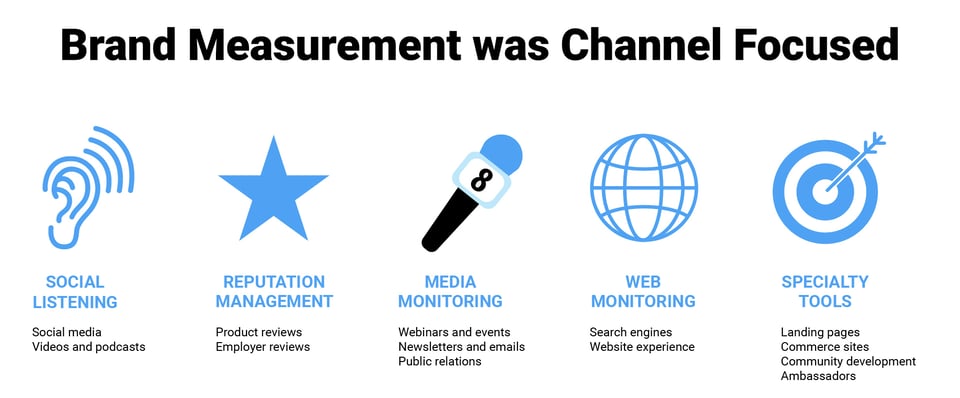
BrandOps is proud to have pioneered a solution: a platform that gives marketers a complete view of their brand health across all digital channels relative to competitors and business outcomes. As proud as we are, we will reaffirm that even a platform like BrandOps reveals only one part of the brand lifecycle. To achieve true end-to-end brand measurement nirvana, brand marketers need to measure and improve their brand throughout the entire brand lifecycle. This means measuring and improving both lagging brand measures using traditional methods (surveys, interviews, etc.), and continuous brand measures and business outcomes using Unified Marketing Intelligence platforms such as BrandOps.
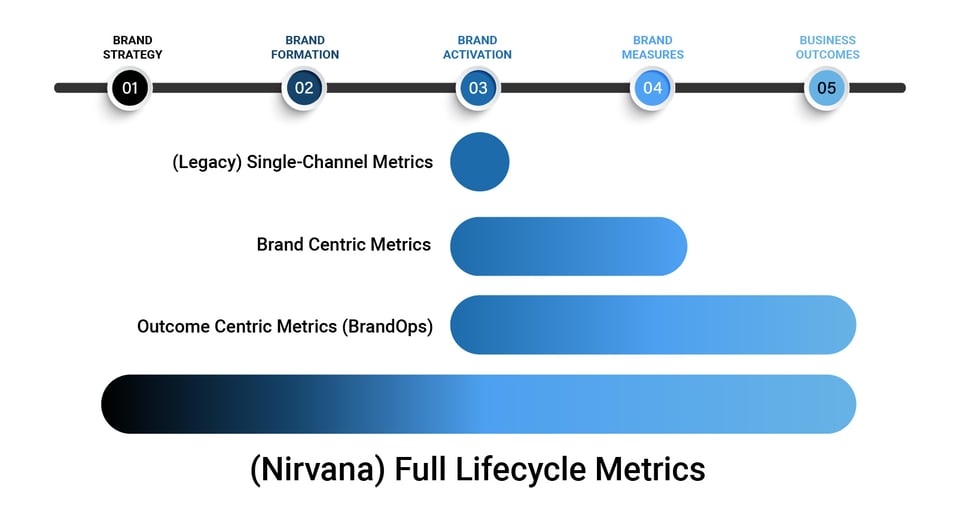
Business Outcomes
At the end of the day, companies invest in brand building because they expect a positive business outcome. This expectation distinguishes brand designers from artists, copywriters from writers, and brands from personal relationships. Brand marketers who cannot create and prove the business outcomes of their efforts get less budget support from finance, experience slower career progression, get relegated to low-priority tasks, or worse -- get fired. Although the business value of strong brands is undeniable, in a world of fast-paced data, the lack of transparency surrounding brand marketing's business impact is seen as a major offense.
The status quo approach makes it very hard to see this impact. Some brand marketers use lagging proxy metrics (e.g. branded search) to prove their impact. Others might do annual surveys on how consumers' perceptions of a brand have changed. While surveys are a supreme method for measuring long-term brand health, they don't match the demands of short-term and medium-term activation in the late brand lifecycle stages. Even though the complete end-to-end brand measurement nirvana is still in our sights, BrandOps is the best option brand marketers have for proving their business impact in the short to mid-term intervals. Brand measurement shouldn't stop at asking whether the brand health improved - it should also answer whether the brand is impacting revenue, market share, and profit.
The end-to-end brand measurement and execution framework
An end-to-end framework allows brand marketers to measure and improve their brands across the entire brand lifecycle - from the inception of the brand, all the way to the business outcomes it creates. An insight into the entire lifecycle allows brands to achieve far greater growth than they ever could before, at a faster pace. Let's discuss what makes this framework superior to any status quo approach, and what it takes to realize it.
1) Continuous brand improvements, not fixed point-in-time improvements.
As it stands, brand marketers cannot improve the full brand lifecycle because organizations are divided into camps with siloed visibility of the brand lifecycle. The camps consist of "classic" brand marketers who strictly operate on long-term timeframes and use manual research and modern brand marketers who operate on medium time frames and use digital touchpoints. Siloed structures like these can only result in one thing: siloed measurements, and siloed improvements that are fixed at a point in time. Going beyond that requires a broader vision made possible by end-to-end brand measurement and execution.
An end-to-end brand measurement and execution framework enables feedback loops across the entire brand lifecycle. The feedback loops are made possible by complete visibility of the brand lifecycle. Brand marketers have insights into areas for improvement at each stage, and they can make those improvements continuously. Brand lifecycle stages reinforce the success of one another, and the insights flow from brand strategy to business outcomes. The brand isn't just waiting for annual campaigns to yield results as its only source of significant growth. The growth that happens in the long term is more effective, and the growth that happens in the medium and short term is more frequent, more supportive of long-term brand activation, and best of all - creates business outcomes.
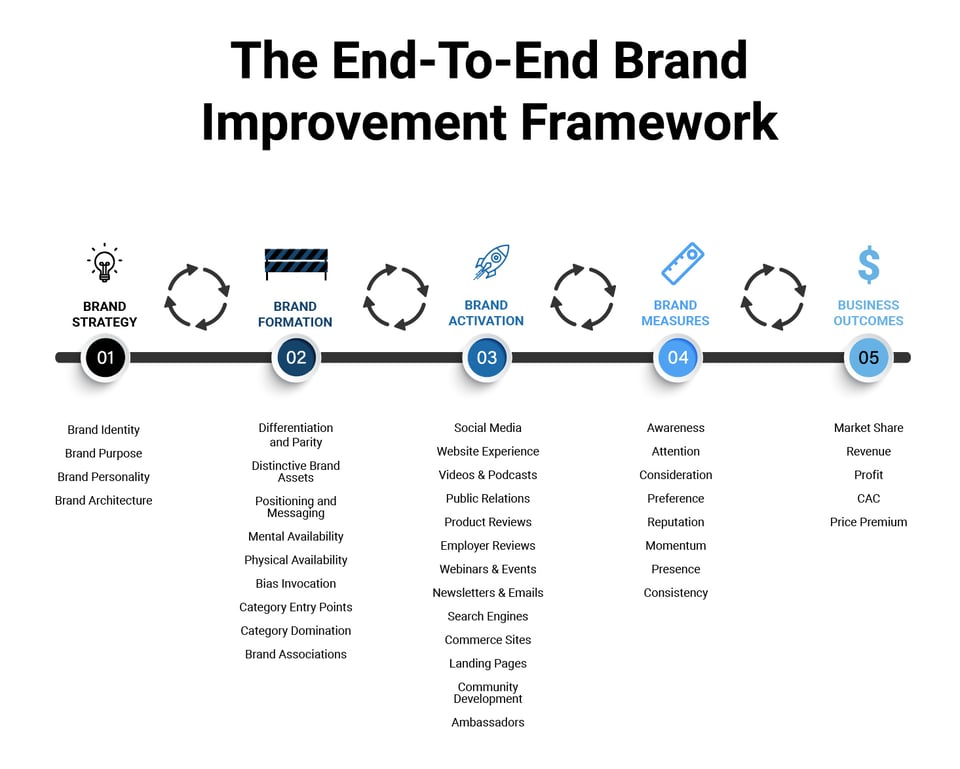
2) No more apples-to-oranges brand measurements.
Previously, brand marketers used a single brand measurement method, usually surveys, as an end-all-be-all solution for any brand lifecycle stage. This produced inaccurate and unactionable insights, because, as we noted, different brand lifecycle stages call for different kinds of brand measures. Long-term brand activation is primarily done for influencing customer thoughts over long timeframes. Lagging methods such as surveys are best suited for measuring them. Medium-term to short-term brand activation is optimal for influencing customer actions and affecting business outcomes in the near future. Measuring them is best done using digital touchpoints and metrics that can be measured and acted upon on a daily basis.
An end-to-end brand measurement and execution framework offers visibility into the entire brand lifecycle. With it, brand marketers can know which measurement method is appropriate for each stage. But that's only the first step. Achieving end-to-end measurement requires the entire marketing organization to align on measurement methods. There should be no dichotomy. Lagging measures and methods (surveys) need continuous measures and methods (digital touchpoints) -- and vice versa.
If they aren't used together over a time series, end-to-end measurement is impossible.
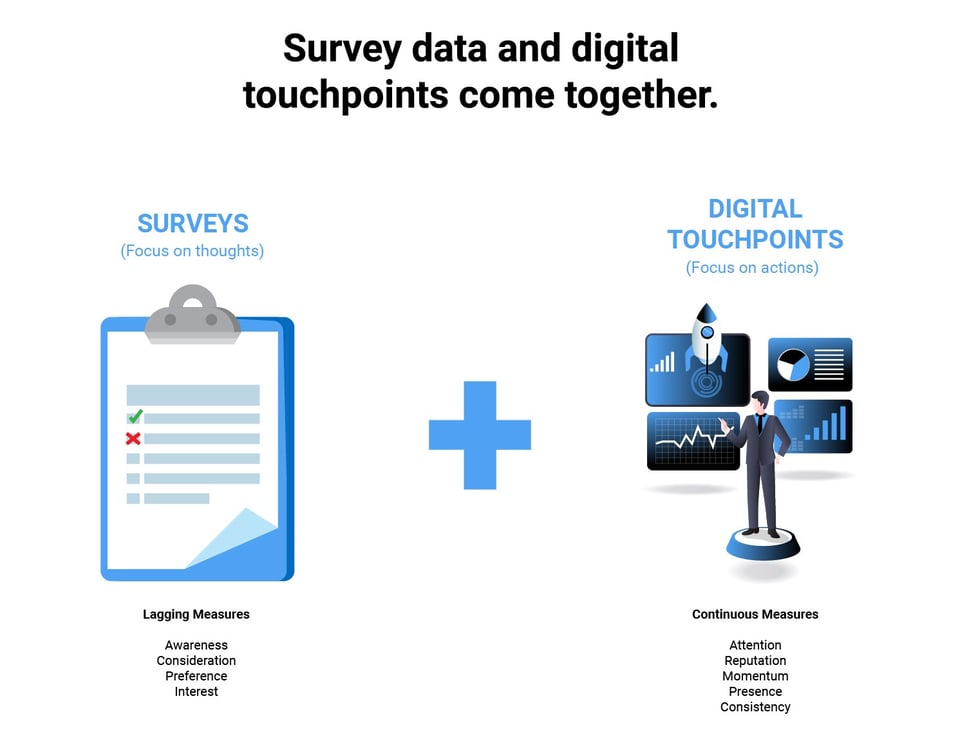
3) Brand spend is more effective, and easier for leadership to support.
Achieving transparency about how all parts of the brand lifecycle, both individually and collectively influence the brand health and business outcomes makes it easy to see where marketing dollars will create the biggest impact. Decision-making on brand marketing spending is based on evidence, rather than guesswork or politics. Brand marketers are no longer incentivized to pursue vanity metrics for the sake of having some demonstrable form of ROI, and leadership extends more support to brand marketing because they are better aligned with the complete, end-to-end brand growth.
The Conclusion
Brand measurement has come a long way, but we can still do better. End-to-end brand measurement and execution is a hard feat
to accomplish, but very much worth it. Realizing it asks marketing organizations to cut the habits they held for so long.
It demands brand marketers care more about creating business impact, not just brand impact. It requires organizations to think about their brands holistically, rather than grouping them into silos of channels, measures, and teams. Lastly, it asks all marketers to put their biases aside and use both surveys and digital touchpoints, both lagging and continuous measures, and both traditional and modern methods. Irrespective of how successfully an organization adopts the end-to-end framework, these demands are still guaranteed to make even the most successful brands much better off.
Are you already doing long-term, traditional brand tracking?
BrandOps might be your missing piece to realizing end-to-end measurement.
BrandOps is a Unified Marketing Intelligence Platform that provides insights that span channels and correlate to business impact.


